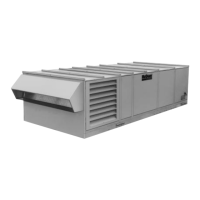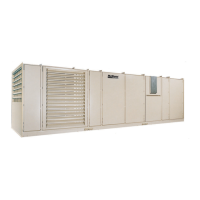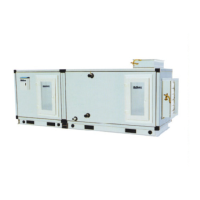Page 74 IM-738
groove variable pitch pulleys must be adjusted an equal num-
ber of turns open. Any increase in fan speed represents a sub-
stantial increase in horsepower required from the motor.
Always check motor load amperage and compare to name
plate rating when changing fan speed.
Figure 81. Fan Rotation
Once the fan has been put into operation, a periodic maintenance
program should be set up to preserve the reliability and perfor-
mance of the fan. Items to be included in this program are:
• Belts
• Bearings
•Fasteners
•Setscrews
• Lubrication
• Removal of Dust/Dirt
Belts
Premature belt failures are frequently caused by improper belt
tension (either too tight or too loose) or misaligned pulleys.
The proper tension for operating a V-belt is the lowest tension
at which the belts will not slip peak load conditions. For initial
tensioning, the proper belt deflection half way between pulley
centers is 1/64" for each inch of belt span. For example, if the
belt span is 64 inches, the belt deflection should be one inch
using moderate thumb pressure at midpoint of the drive,
See Figure 82.
Check belt tension two times during the first 24 hours of oper-
ation and periodically thereafter. To adjust belt tension, simply
loosen four fasteners (two on each side of the motor plate) and
slide the motor plate away from the fan shaft until proper belt
tension is attained. On some fans, fasteners attaching the motor
to the motor plate must be loosened in order to adjust the belt.
It is very important that the drive pulleys remain in proper
alignment after adjustments are made. Misalignment of pulleys
will result in premature belt wear noise, vibration and power
loss, See Figure 83.
Figure 82. Belt Adjustment
Figure 83. Drive Pulley Alignment
Bearings
Bearings are the most critical moving part of the fan and
should be inspected at periodic intervals. Locking collars and
set screws, in addition to fasteners attaching the bearings to the
bearing plate, must be checked for tightness. In a clean envi-
ronment and temperatures above 32°F./below 200° F., fan shaft
bearings with grease fittings should be lubricated semi-annu-
ally using a high quality lithium based grease. If unusual envi-
ronmental conditions exist temperatures below 32°F. / above
200°F., moisture or contaminants, more frequent lubrication is
required.
i r f l o w
A i r f l o w
R o t a t i o n
R o t a t i o n
B e l t S p a n
D e f l e c t i o n =
B e l t S p a n
6 4
C e n t e r l i n e s
m u s t c o i n c i d
M u s t b e
p a r a l l e l
M u s t b e
p a r a l l e l
A d j u s t a b l e
S h e a v e
M o t o r
B e a r i n g

